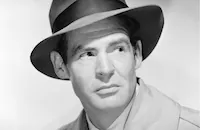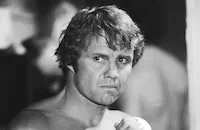Hour of the Gun

Brief Synopsis
Cast & Crew
John Sturges
James Garner
Jason Robards Jr.
Robert Ryan
Albert Salmi
Charles Aidman
Film Details
Technical Specs

Synopsis
In 1888, following the bloody gun battle at the O. K. Corral in Tombstone, cattle rustler Ike Clanton, the man responsible, contrives the arrest of the Earp brothers (Wyatt, Virgil, and Morgan) and their whisky-soaked, tubercular friend, Doc Holliday. The murder charge is dismissed, however, and young Virgil consents to run for city marshal; but Clanton's henchmen trap and badly wound him. Morgan is killed when he volunteers to take his crippled brother's place on the ballot. As Wyatt, accompanied by Doc, is escorting Virgil and their dead brother back to the Earp homestead in California, he receives a telegram informing him that he has been appointed Federal marshal. Doc assists in forming an authorized posse, and they set out after Clanton. On the trip, Wyatt picks off Clanton's men one by one with such coldblooded indifference that even Doc is shocked by his friend's disregard for human life. Suffering a hemorrhage, Doc is forced to admit himself to a sanitorium, but Wyatt continues on to Mexico, where Clanton is now engaged in a new cattle-rustling enterprise. Eventually Wyatt traps his prey in a small village and kills him. Having evened the score, he returns for a farewell visit with Doc. As Wyatt leaves the deathbed, he removes his gun and cartridge belt, stows them in his saddle bag, and vows never to be a lawman again.

Director

John Sturges
Cast

James Garner

Jason Robards Jr.

Robert Ryan

Albert Salmi
Charles Aidman
Steve Ihnat
Michael Tolan
Frank Converse
Sam Melville
Austin Willis
Richard Bull

Larry Gates
Karl Swenson
Bill Fletcher
Robert Phillips
William Schallert

Jon Voight

Lonny Chapman
Monte Markham

William Windom
Edward Anhalt
Walter Gregg
David Perna
Jim Sheppard
Jorge Russek
Crew
Edward Anhalt
Joan Arnold
Lucien Ballard
Sass Bedig
Charles Blackman
Lawrence J. Cuneo
Gordon Dawson
Joe Edesa
Nate H. Edwards
John Franco
Victor Gangelin
Bud Gaunt
Jerry Goldsmith
Jesús González Gancy
Jack Harris
Robert M. Jones
Harry Kemm
Joe La Bella
Jack Lacey
William Maldonado
Terry Meade
Mirisch Corp.
Thomas J. Schmidt
John Sturges
John Sturges
David M. Walsh
Ferris Webster
Alfred Ybarra

Videos
Movie Clip




Hosted Intro



Film Details
Technical Specs

Articles
Hour of the Gun
Hour of the Gun, released in 1967, is considered to be director John Sturges' finest film. Starring James Garner as Earp and Jason Robards as Doc Holliday, it was released a decade after Gunfight at the O.K. Corral (1957) (also a Sturges film) and is considered the sequel. Indeed, the film opens with the shootout at the corral and builds its story from that event. On the surface, Hour of the Gun appears to be a typical Western--a struggle for power between the forces of evil and good, in this case, a political battle for control of Tombstone. Yet Sturges presents an undercurrent plot more sinister than the typical cowboy fare, a realistic look at the conflict between moral righteousness and the temptation of personal revenge.
Following the explosive opening scene, the action moves to the murder trial of the Earp brothers. We are introduced to the antagonist Ike Clanton, supremely played by Robert Ryan, a character with so little scruples as to sacrifice his son for a firmer political grasp on Tombstone. It quickly becomes evident that Clanton will stop at nothing to achieve his goal, and with the Earps posing as the only obstacles in his path, he sets out to destroy them, first (rather ironically) in a courtroom, then, failing that, anywhere he can exact his revenge on them.
The narrative, set against the stunning backdrops created by the keen eye of cinematographer Lucien Ballard, actually serves as a critique of the Earp legend. The audience becomes witness to the moral crumbling of a man hiding behind a badge and yet succumbing to his bloodletting temptations. Garner, in one of his most challenging roles, portrays Earp as an embittered, paranoid lawman. Jason Robards, on the other hand, infuses Holliday with a sense of humor and an unparalleled sympathy. In fact, Holliday is given the best lines in the film, and Robards consistently steals every scene he is in: as Holliday advances with gun drawn upon Curly Bill Brocious, a bystander shouts out in protest, "He's drunk, Holliday," to which he replies without missing a beat, "So am I."
The action builds to the inevitable meeting of Earp and Ike Clanton, although by this point, the showdown is no longer a clean contest of good versus evil. Earp has emerged from his moral battles scarred and bloody, and must make the final decision to abide by or reject the law.
Hour of the Gun was not well received at the time of its release, but it is not difficult to understand why. The proffering of a fallen king, a hero weakened and ultimately destroyed by desire and revenge, was unprecedented in the sixties Western film genre. Today's audiences are much better suited to this kind of characterization; indeed, we demand it for the sake of realism. Hour of the Gun, therefore, is anointed as a film ahead of its time, a film with an increased potency of social relevance more than thirty years after its creation.
For collectors of trivia, look for Jon Voight (Midnight Cowboy, 1969) in one of his first film roles. And yes, that's screenwriter Edward Anhalt in a cameo role as the medic who tries to keep the tubercular Doc Holliday alive.
Director/Producer: John Sturges
Screenplay: Edward Anhalt
Cinematography: Lucien Ballard
Editor: Ferris Webster
Art Direction: Alfred C. Ybarra
Music: Jerry Goldsmith
Cast: James Garner (Wyatt Earp), Jason Robards (Dr. John 'Doc' Holliday), Robert Ryan (Ike Clanton), Albert Salmi (Octavius Roy), Charles Aidman (Horace Sullivan).
C-102m. Letterboxed.
by Eleanor Quin

Hour of the Gun
Quotes
Trivia
Prior to production, United Artists had made it quite clear to director John Sturges that none of the primary roles were to be filled by the actors who played the same characters in Sturges's previous Wyatt Earp film, Gunfight at the O.K. Corral (1957). Wanting to distinguish this film from the previous one, they demanded different actors be cast in the roles. However, Sturges believed that the roles of Virgil and Morgan Earp from the previous film were small enough that the same actors who played them could do it again without harming the film's uniqueness. The studio agreed and allowed Sturges to cast 'John Hudson' (who played Virgil Earp) and DeForest Kelley (who played Morgan Earp). Unfortunately, Hudson had retired from acting in the early '60s and was unwilling to do play his role. DeForest Kelley, on the other hand, was currently working on the TV series "Star Trek" (1966), and was unable to break away to play Morgan Earp. Thus, both Earp brothers were recast.
Notes
Location scenes filmed in Mexico. Prerelease title: The Law and Tombstone.

Miscellaneous Notes
Released in United States Winter January 1, 1967
After the OK Corral shoot-up, Wyatt Earp chases down his enemy and then retires his gun.
Released in United States Winter January 1, 1967













